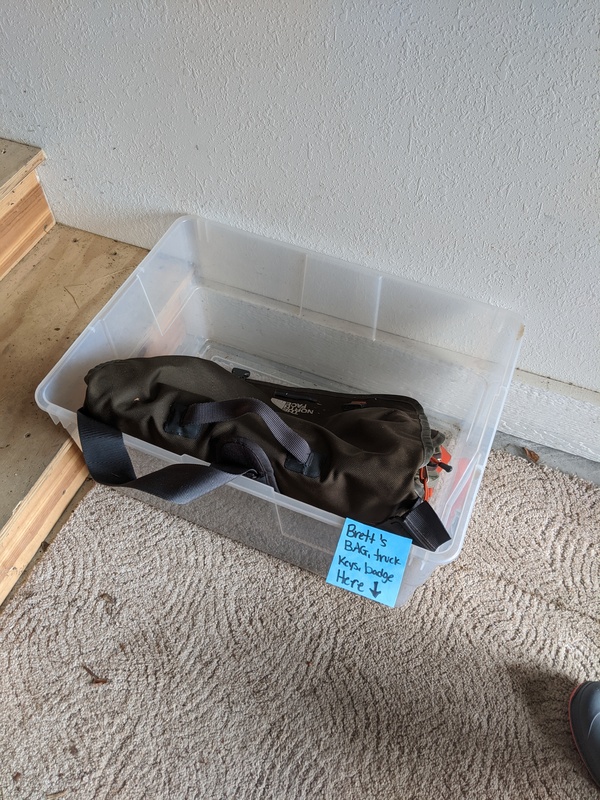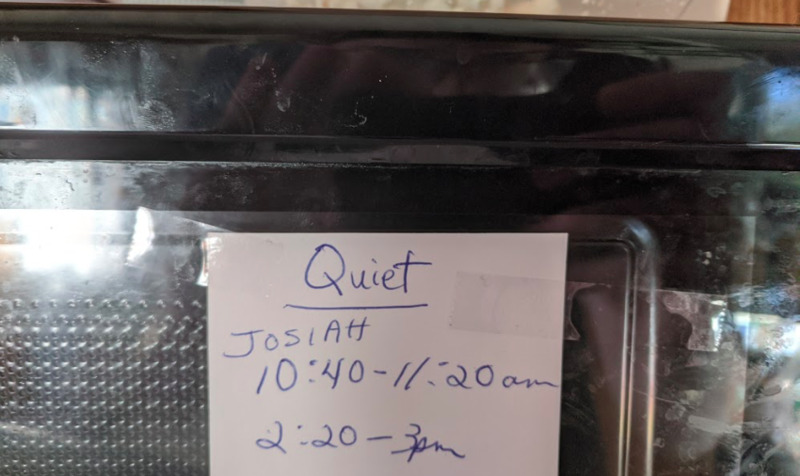Family and Work in the Homespace
By: Lauren Whyte and Jordan Grabanski
In response to the coronavirus pandemic, families have had to make substantial adjustments to their day-to-day home lives--especially for families with essential workers. They face all sorts of pressures: a need to protect their most vulnerable members, to create separate and quiet spaces for work, and to handle being in an enclosed space with one another for extended periods of time. This archive is dedicated to family and work in the homespace. It focuses on life with essential workers, adjustments made for working from home, family dynamics, and extended family communication.
Home Life with Essential Workers
Everyone’s quarantine is different, but those families who have essential workers have a very different quarantine and home life. Instead of social distancing to avoid getting COVID-19, they social distance to prevent spreading COVID-19. Lauren Whyte shares her story of what it is like to have her dad working in the emergency department of their local hospital during this pandemic. Lauren explains how her family had to make a decision at the beginning of the pandemic: stay home with her dad or move to a different location. She said “my mom and dad really wanted us to leave, for our safety, but eventually we decided to stay together” (3/1/20). However, staying together meant a lot of extra precautions. As you see in the pictures, her dad has to leave all his work stuff outside and disinfect everything before entering the house.
As for the rest of her family, they did all they could to prevent spreading the virus, including ordering all groceries online to prevent touching things in stores. They acted as if they were infected. Her family even went as far as having her mother move out of her bedroom into the guest room. It was all going okay in the beginning, Lauren said, but eventually it just got really hard. Her mom eventually moved back into her bedroom, but there were a lot of other social problems. Lauren said, “My mom said she feels like the plague because my dad is exposed to the virus everytime he goes to work, so her friends are scared to be anywhere near her. My dad is having a similar experience, anyone outside of my family is scared to be near him” (4/21/20). She continued to express that it just seems like a waiting game until she gets sick, and even though her family is being careful her chances of getting sick are very high. As for her dad, she was able to share inside knowledge of what health care workers have to do before going home to their families. Lauren said that her dad brings a complete change of clothes to work and leaves them in a clean space. He leaves his work shoes at work, never bringing them or his scrubs home. In addition, he takes a shower once his shift is done and before he touches any clean clothes. Having family members as essential workers makes Lauren’s quarantine very different. Instead of having to just take precautions outside their house, people in Lauren's situation have to take precautions both in and out of the house. It creates a lot more stress and is a lot more work.
Lauren's friends and neighbors in Winona, Minnesota have a different experience. Emma Hanson, a bagger at a local grocery store, reports that “Personally it seems pretty normal besides the regulations at work” (5/6/20). She has to wear gloves, masks, and uses protective shields. She did mention that her family makes sure her work clothes get washed as well as her mask, and that she washes her hands before entering the house. It is really interesting to see how different families take different levels of precautions.
Work in the Home Space
Completing work at home requires not only changes in student work habits, but it can also put a strain on families as well. The need to create both separate and quiet spaces for work, especially for synchronous class sessions, affects the whole family. Furthermore, class schedules can change rapidly as educators continue to adjust to the pandemic, and with particular Zoom appointments, making it difficult to know when it is time to be quiet and when it is time to start banging pots and pans. Working from home, requires a lot of communication, patience, and adjustments that differ for each family.
To deal with this problem, Jordan’s family established a weekly “quiet” schedule. On the kitchen counter sits a notecard where anyone can write down the times it needs to be quiet. During those times people in the house stay upstairs, as two of them (including the youngest brother in high school, who has the most synchronous class sessions) have rooms downstairs where they work. Jordan writes in his journal, “The first floor of my house doesn’t fully exist from 8-3” (4/25/20). Lauren’s family took a bit of a different approach. Lauren’s household has four students and one, her brother, is currently in his second year of law school, so his workload is quite heavy.
As a result, the house is quiet for almost all of the day. If someone absolutely needs quiet, they send a text out to the family. Lauren says that most days, “I cannot watch TV unless it is in my room on my laptop and I cannot be loud in the kitchen unless everyone is on a study break” (4/14/20). Lauren writes that one day, her brother even hid the TV remote because he had an exam and could not trust that no one would watch TV. This need for quiet has created a lot of tension and sparked many arguments in her house, but in the end everyone knows that it is needed for good reason. Finals week has brought extra challenges to Lauren’s house. Her brother has finals that take three hours to complete and he needs complete silence. She writes in her journal that one day she took her dog and the car down to the local lake and sat in the car doing homework for the duration of his final.
Family Activities
As a result of social distancing, people within families have been away from friends and stuck together for extended, uninterrupted periods of time. Family has been substituted for friends, and there is an increase in the number of activities done with siblings, parents, and the family as a whole. Just as there are commonalities between people’s quarantine experiences across households, like new walking habits, those commonalities can occur within the same household as well. When they do, they might decide to do that activity together.
What those activities are range from watching TV shows, to playing games, to the aforementioned walks. “Card games in particular made a surprising comeback, Jordan writes. “Before quarantine, I don’t think my brothers and I have played any card game with our dad since I was a little kid” (4/5/20). Lauren’s family had a Harry Potter movie marathon. They rewatched one movie a day, in order. Her family has also been going on a lot of walks and giving the family dog some extra attention. They even decided to get another puppy come June, which has really helped mentally. It gives her family something to look forward to, and they have created a rank voting system for names as a new family activity. Lauren wrote in her journal that she and her sister have been baking a lot, and is an activity that many families seem to be doing. Lauren mentioned her trip to the grocery store and expressed “they were out of yeast too. I guess everyone is making bread and other baking goods” (4/6/20).
Of course, it’s far from a perfect picture. There are annoyances and conflicts that increase by constantly being surrounded by one another. People will sit outside to do homework, talk with friends, or plainly avoid one another for a while. Lauren expresses in her journal,“I get mad really easily and I can not be around my family for too long without wanting to scream” (4/9/20). Her journal starts out saying that quarantine was a nice mental break, but we see as it progresses the mental toll it has taken on her and her family.
All the normal family stuff applies, but all the more intense from constant interaction.
Extended-family and Inter-familial Dynamics
Extended families often include people across different households, and a single “immediate” family may have different members staying at different places during the pandemic as well. An extended family might need to coordinate to protect its most vulnerable individuals or households. Biweekly, Jordan’s mom would take the two-hour drive to visit and grocery shop for her parents, while others avoided visiting them to limit the risk of exposure. Lauren’s family is not allowed to see any extended family in person. They have a lot of Zoom meetings to stay connected and if something needs to be dropped off it sits outside the house for a couple days. If anyone does decide to go visit family we sit 6-feet apart and all wear masks.
Lauren’s extended family have all been reacting in different ways. For example, one side of grandparents have been taking this seriously and not leaving their house; however, her other grandpa seems unphased by the pandemic. He mentioned everything feeling normal in his neighborhood, and has not noticed any differences in people's attitudes.






